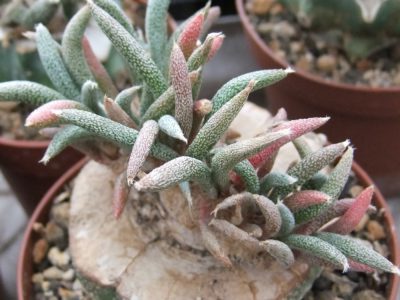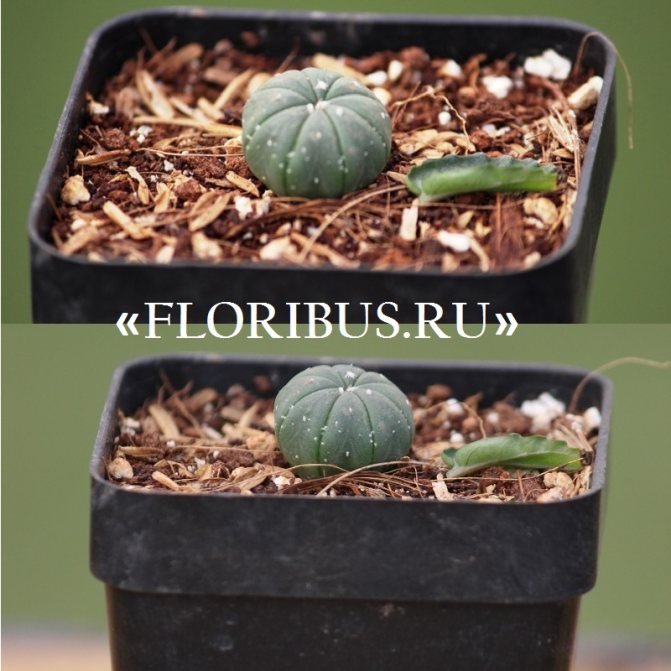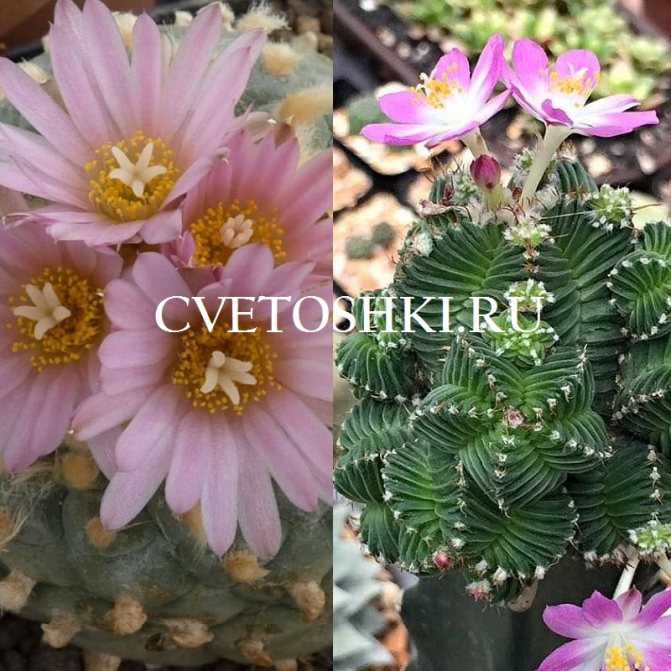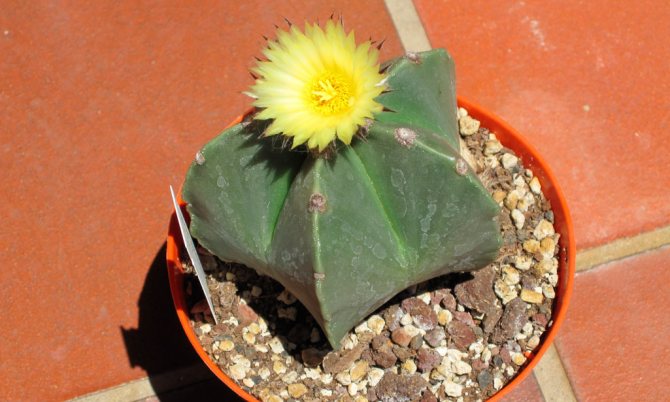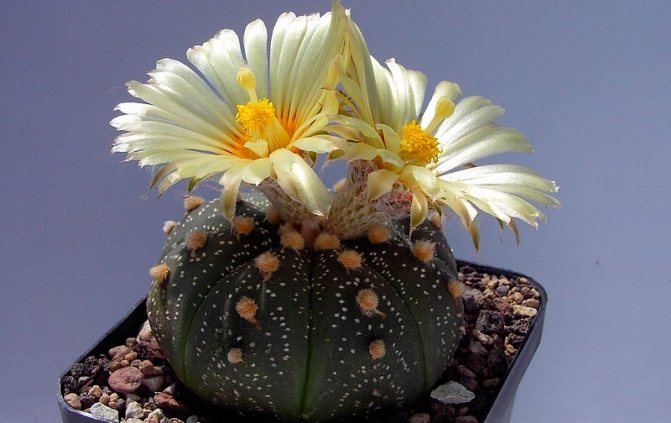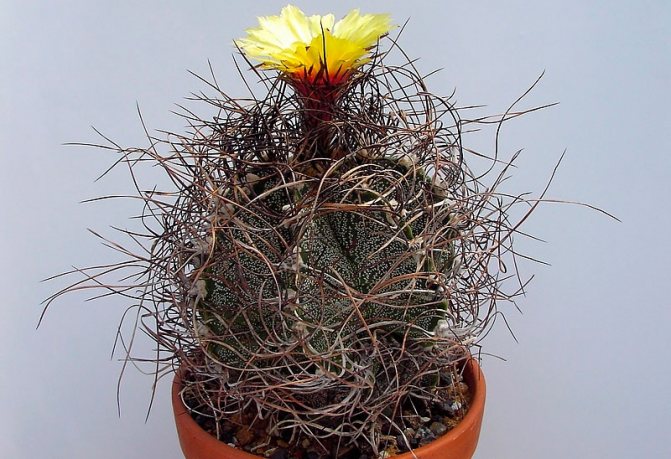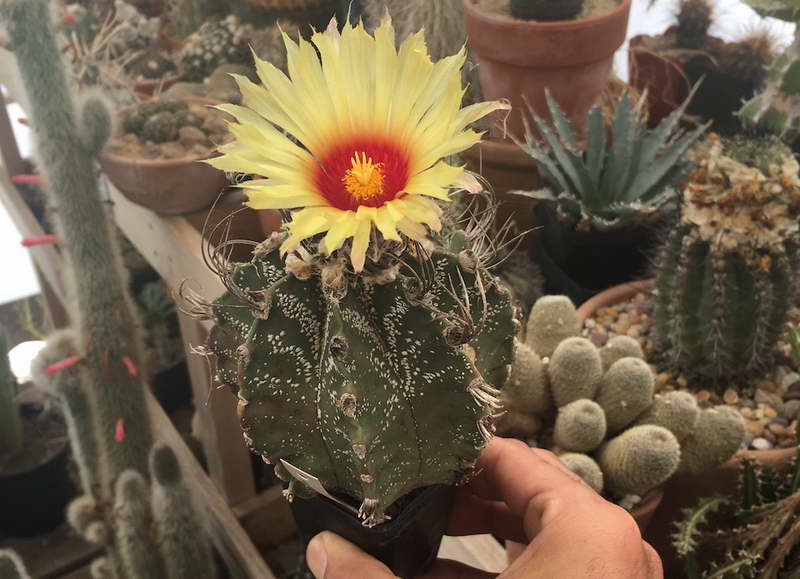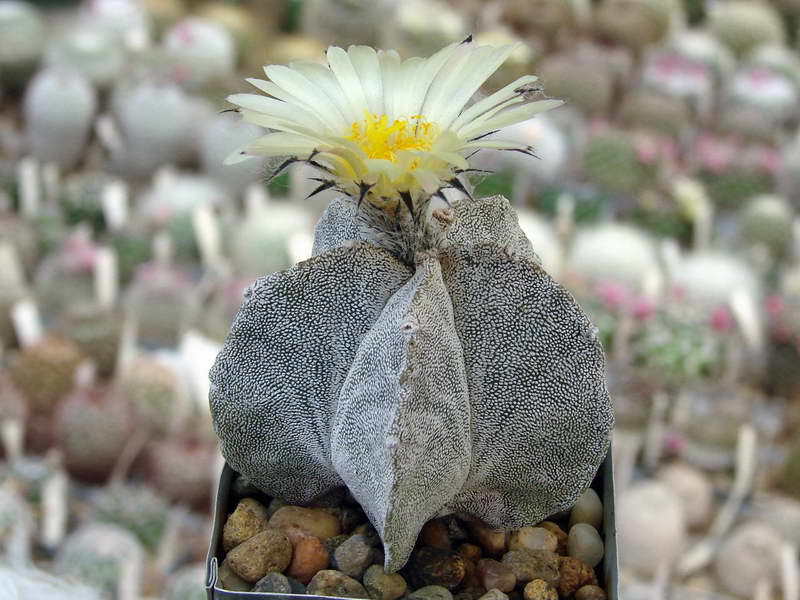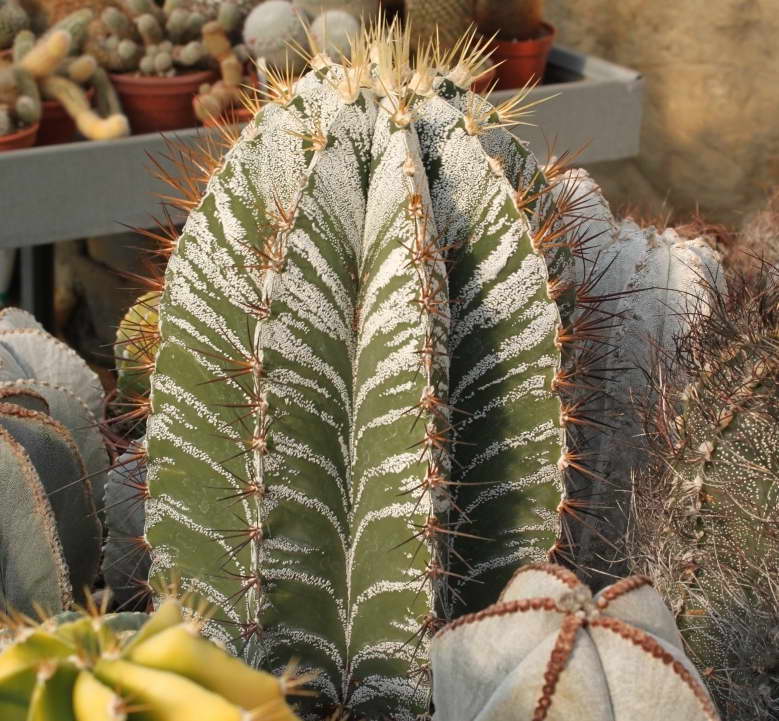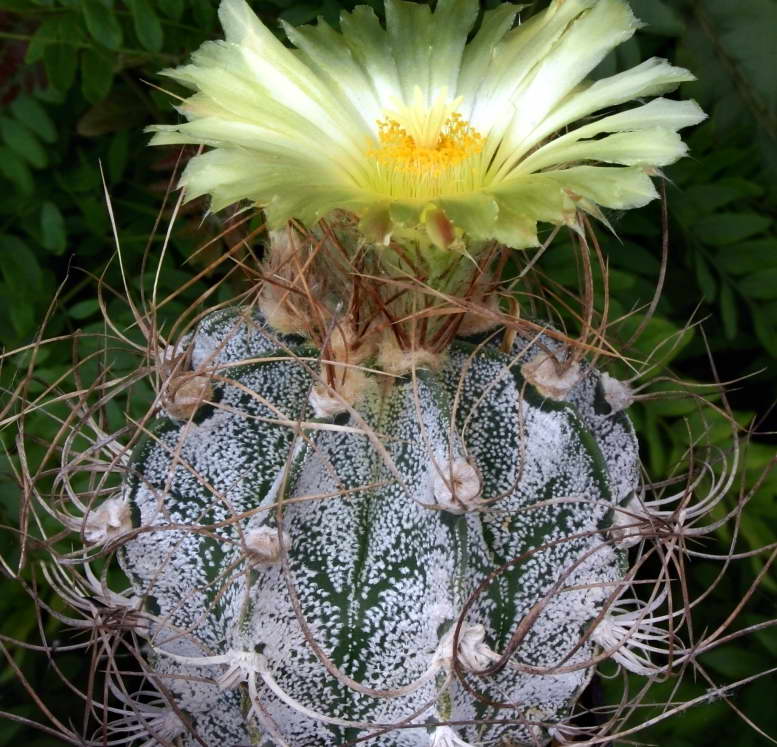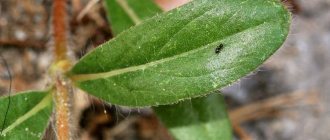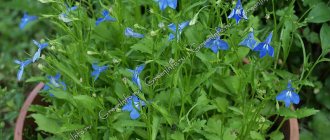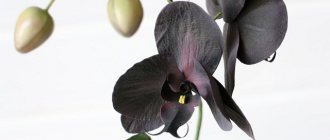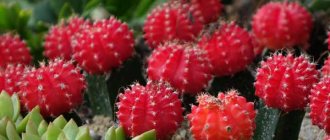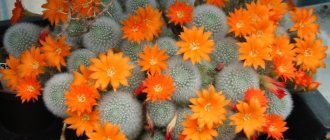Desert Astrophytum cacti are native to Mexico and South America. The name itself is translated very nicely: "astro" - a star and "phytum" - vegetable. There are many cultivated varieties, and they are quite common among flower growers. Most of the cacti have a proportionally rounded trunk, the ribs can be strong and weak.
The trunk color is usually brown-green, with light specks or spots. Few species of Astrophytum have large spines, as a rule, they are either absent at all, or the spines are weakly expressed. Blooms in summer, flowers are located at the top, single, large. The color of the petals ranges from white to egg yolk. The inner part of the flower is reddish-orange in color.
In this article you can get acquainted with rare species of Astrophytum and their photographs: "Cacti with names starting with the letter" A "- a list of species."
2.Care for astrophytum at home
2.1 Reproduction - growing from seeds
The cactus is easily propagated by seeds at a temperature of 21 ° C - 26.6 ° C. Seed germination depends on the degree of maturity during collection and the freshness of the seeds.
2.2 How to care
This cactus is popular as a houseplant. The plant will bloom at approximately 3 years of age. The dormant period in winter stimulates active growth and flowering, during this time the cactus should be watered less and the temperature should be reduced to about 13 ° C.
2.3 Flowering time
2.4 Diseases and pests
The cactus does not bloom if there is insufficient light or the absence of a cool dormant period. Mealybug, scale insect. Decay when waterlogged and stagnant water, especially in the cold season.
2.5 Primer for astrophytum
Ideal for cactus soil, consisting of perlite, peat and compost, ready-made mixtures for cacti. On top of the soil, it is advisable to pour small pebbles about 2 - 3 cm high for the best drainage.
2.6 Transplant
Young plants (up to 3-4 years old) each year in the spring as they grow into a larger pot. For adults, replanting every 3 to 4 years is sufficient. This cactus has rather sharp thorns, care should be taken to protect your hands when working with it.
2.7 Containment Temperature
Temperatures in the range of 15 - 21 ° C from spring to autumn are considered optimal for growing cacti at home; wintering of cacti should take place in a cool place - at a temperature of 10 - 12 ° C.
2.8 Watering astrophytum
It is best to water the plant when the soil becomes dry from spring to late fall. In winter, keep it almost dry, only so that the stem does not wrinkle.
2.9 Light
Desert cacti love the sun and will grow well if you provide plenty of sunshine.
2.10 Fertilizer
Only during the growing season, once a month, with a fertilizer for cacti with a low nitrogen content.
2.11 Spraying
No special requirements, it tolerates dryness of heated rooms well.
2.12 Purpose
It is a slow growing plant suitable for a cactus garden or group planting in a shallow container covered with gravel.
2.13 Note
These are easy-to-cultivate cacti and are great for beginners; when growing them, you should pay special attention only to the need for a dormant period.
Diseases and pests
- The main pests of Astrophytum are mealy and root bugs, scale insects... If the colonies of scale insects and mealybugs are not large, you can try to get rid of them with a soap solution - wash them off. If there are a lot of pests, then you will have to use an insecticide.
- It is more difficult if the plant is affected by root worms - they cannot be seen with the naked eye. But a cactus affected by them stops growing and looks depressed. And if you look at the root system, you will see a white bloom on the roots. To heal the plant, you need to remove all the old soil and make it a root bath with water, the temperature of which is about 80 degrees. Then sprinkle the roots with sulfur powder and let dry. Only after that, plant in a new pot with fresh soil.
- Astrophytums can get sick from high humidity and cold temperatures. Therefore, in a prolonged bad weather, it is necessary to carry out the cacti from the fresh air.
- You can not take out cacti in damp basements in winter - this will serve as the onset of the disease. It is almost impossible to treat them, the plants rot and die.
3.Varieties of astrophytum:
3.1. Astrophytum myriostigma - Astrophytum myriostigma
Single growing cacti with spherical green stems covered with silvery specks. Often, with age, the stems take on a cylindrical shape. Ribs from 3 to 5 - they are vertical or slightly twisted, widely spaced and well pronounced. There are no thorns. Flowers are yellow, funnel-shaped, appearing at the top of the stem.
3.2.Astrophytum decorated or ornatum - Astrophytum ornatum
Very variable appearance - the stems can have a different number of ribs and differ in shades in different plants - some are green, while others are densely covered with light specks. The fastest growing astrophytum. The spines are strong, short, straight, sparse. The flowers are lemon yellow, with a diameter of 7 - 12 cm.
3.3. Astrophytum capricorn - Astrophytum capricorne
A. ibex is also very variable - some cacti have very long and curled spines, while others show a complete lack of thorns. The number and size of hairy specks characteristic of astrophytums varies greatly. Flowers are orange-yellow, funnel-shaped.
You may also be interested in:

Many animals and plants have a star shape in nature: starfish, sea urchins, fruits, fruits. In cacti, the star-shaped stem is generally widespread.
But she received the most perfect embodiment in the small in number, but the most popular genus Astrophytum myriostigma. These are excellent neighbors for "lazy gardeners" due to their unpretentiousness. Moreover, it is a great addition to any interior.
Popular varieties (cultivars)
Astrophytum capricorn (Astrophytum capricorne)
Wonderful view of Astrophytum. In conditions close to natural, it can reach a height of 30 cm, and a diameter of 17 cm. At a young age it has a round shape, as it grows, it stretches into an ellipsoid. The round barrel is usually divided into 8 parts, but there are various deviations. The specks completely cover the stem of the plant, almost overlapping the natural green color.
On the upper part of the ribs there are areoles covered with hairs, from which long spines grow. 6-7 spines, almost ten centimeters, from each areola, twisted like goat horns. From this came the name of this variety. In adulthood, they entangle the entire trunk. Flower buds open in early summer or late spring. The color of the 6 cm petals ranges from bright to light yellow.
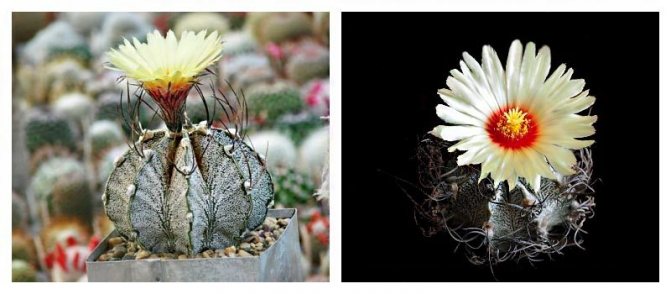

A. capricorn
Astrophytum speckled (Astrophytum myriostigma) myriostigma
This Astrophytum has a smooth trunk covered with velvet specks. Most often it has 5 pronounced ribs, which is why it was nicknamed by flower growers "Bishop's miter".With age, it reaches a circumference of 20-25 cm. There are areoles with villi on the ribs.
This cactus blooms with bright yellow flowers, pointed at the tips of the petals with a brown border. A rounded pistil and protruding stamens are located inside the flower. Blooms in summer, but only 2-4 days. When ripe, the fruit pods reveal stellar figures, which also looks very decorative. Some varieties have no speck at all. But the biggest advantage is that all subspecies are very unpretentious to care for.
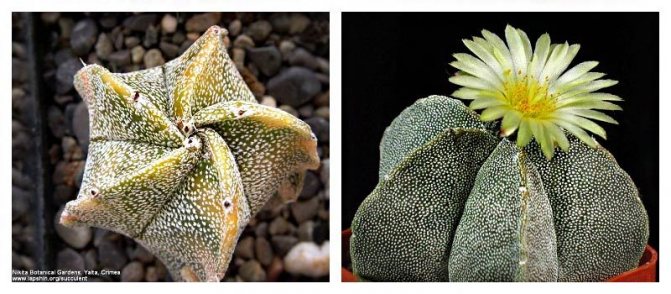

A. speckled
Star astrophytum (Astrophytum asterias)
Originally from areas of northern Mexico. This cactus has a slow growth rate. Its trunk is spherical, slightly flattened downward. Ribs are very poorly defined and there are only about 6-8 ribs. The color of the barrel is brownish green. The original areoles are located approximately in the middle of the ribs. Around them there is a white speck. The areoles themselves have an even round shape, from which long, sharp spines of brown grow. From the areoles, the cactus produces flowers of a light yellow color with a red center, the diameter of which is 7 cm. They open in summer and only during the daytime. This species served as the basis for the development of dozens of new varieties.


A. star-shaped
Astrophytum coahuilence (Astrophytum coahuilence)
Differs in life expectancy. With proper care, it grows in a circle of 25 cm and a height of more than a meter. In young plants, the ribs are deep and clear, but they compare with age.
The surface of the cactus, which has a rich green color, is dotted with gray dots, and completely devoid of thorns. Areoles become visible only with the beginning of flowering. This Astrophytum has lemon-colored flowers with an orange-red center.
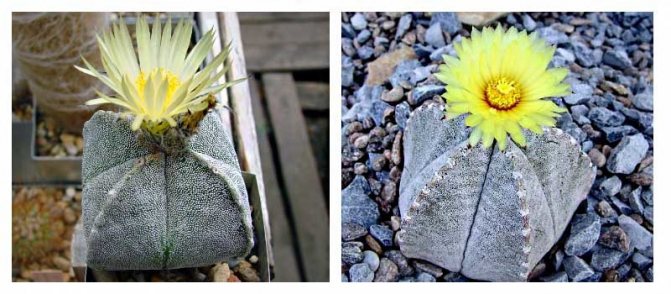

A. coahuilense
Decorated astrophytum (Astrophytum ornatum) ornatum
This cactus is not demanding to care for. In indoor conditions it grows up to 30-40 cm. The specks are arranged in interesting almost completely horizontal stripes. The specks are mainly located on the ribs of the trunk and give the impression of a plush pattern. It has brown spines.
It blooms late, only in the 6th year of life, if its height has reached 15 cm. Flowers depend on the variety of this plant. Most often, flowers have light yellow shades of different saturation.
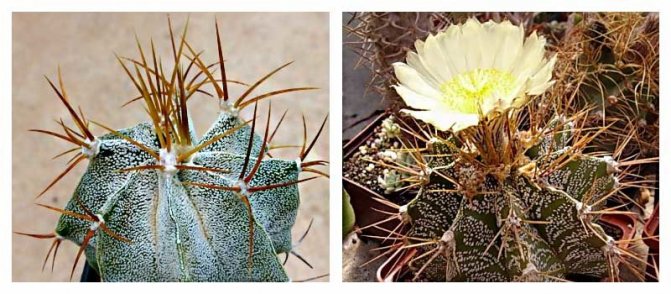

A. decorated
Astrophytum Kabuto or Super Kabuto (Astrophytum Сabuto)
Super Kabuto is a whole family of randomly cracked Astrophytum patterned with some other kind. The Japanese M. Takeo found a neglected mother plant in one of the nurseries in America. Having put the plant in order, he waited for fruiting and planted seeds. Of the seedlings, only about 30% inherited maternal characteristics. Unfortunately, further hybrids very rarely repeat the distinctive features that were originally.
The following features remained unchanged: the Super Kabuto variety - White Snow, has trunks completely covered with white specks, and the Zebra or Tiger variety, where specks are lined up in various stripes.
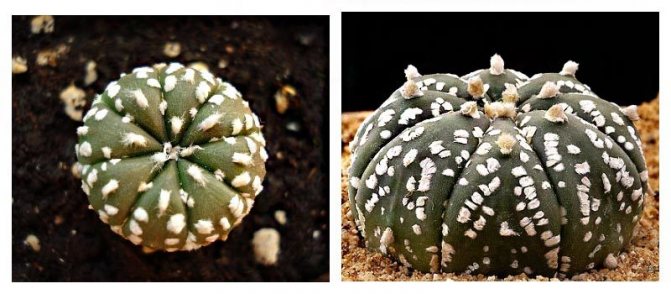

A. Super Kabuto
Appearance
- The size of the plant. Astrophytum myriostigma is a desert spherical cactus. In natural conditions, it reaches a height of 1 m and 20 cm in diameter.
- Stalk of a young shoot is a small ball that lengthens as it grows. It has an ash-green color, without thorns. Covered with specks, which are actually tufts of villi.
- Ribs. Has 5 - 6 thick ribs. There are tubercles on the edges of the ribs.
- Funnel-shaped flowers appear at the top of the stem. Bright yellow with reddish edging.
- Fruits and seeds. The diameter of the fruit reaches 2 cm, green in color, the seeds when ripe are red-brown, covered with scales with a long pile.
The birthplace of astrophytum myriostigma is Mexico and the south of the United States, an area of a sultry and arid climate.
Astrophytum photo


Astrophytum capricorne
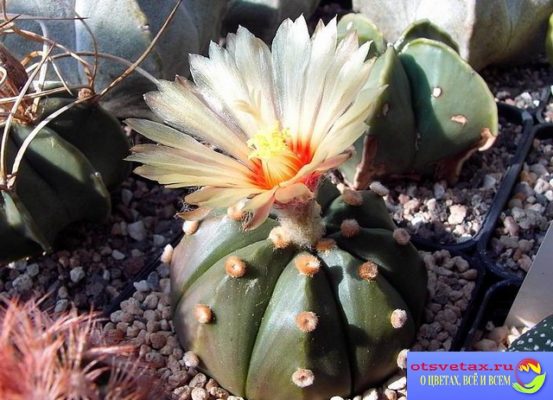

Astrophytum_asterias


Astrophytum caput-medusae
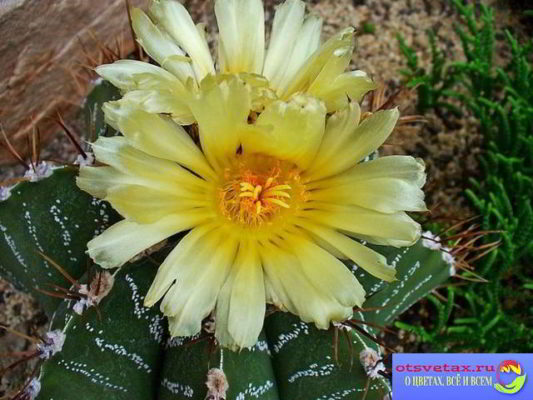

Astrophytum ornatum


Astrophytum myriostigma


Astrophytum coahuilense
How to take care at home?
Caring for astrophytum myriostigma is not difficult. Indeed, in the natural environment, it grows in rather unfavorable conditions: sultry heat, lack of moisture.
Temperature
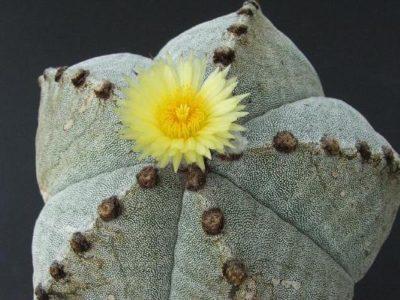

In summer: high air temperature is not a problem for the plant. It is reasonable to place astrophytum in the open air - balcony, terrace, protecting it from precipitation.- Autumn: the flower is preparing for rest. Reduce the temperature gradually.
- In winter: a sufficiently low temperature is required. Up to ten degrees.
- In the spring: a gradual increase in temperature to high summer degrees.
Watering
Watering is preferable from the pallet, also taking into account the season:
- In summer: as the soil dries up.
- In spring and autumn: once or twice a month.
- In winter: watering for astrophytum is not required.
Overflow promotes decay of the roots and base of the stem.
Astrophytum is photophilous. Doesn't like shadow. You only need to shade it in the heat.
Priming
The substrate for astrophytum consists of coarse sand, peat, sod and deciduous soil in equal parts. When planting a plant, a drainage layer is laid on the bottom of the flowerpot.
Top dressing
Produced from mid-spring to mid-autumn, once every 3-4 weeks. Special fertilizers for cacti are used as nutrients.
Pot
The size of the container is selected depending on the size of the plant. For small specimens, a pot with a diameter of 6 - 8 cm is usually taken. Considering that the root system of astrophytum does not grow deeper, a flat flowerpot is needed.
Transfer
A transplant is performed only in case of urgent need, no more than once every 3 to 5 years. More often if necessary. Astrophytums do not tolerate transplantation well.
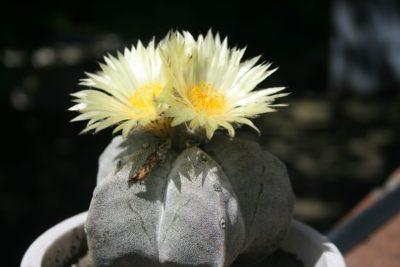

The reasons for the transplant can be:
- The overgrown root system filled the entire volume of the container.
- Damage to the root system by rot or pests.
The correct astrophytum transplant is performed in this order:
- Distribute the drainage in the container in a layer of 2.5 - 3 cm.
- Fill the container one third with a special cactus substrate.
- Carefully remove the cactus from the old pot and pay special attention to the root system:
- Gently clean the roots from the soil.
- Inspect the root collar and roots for decay and pests.
- Remove rotten roots.
- Gently spread the roots and place in a flowerpot, gradually adding soil between them.
- Pour the soil up to the root collar and place the top drainage in a small layer.
Care
Watering
- During the period of growth activation, regular and moderate watering is needed.
- It is worth maintaining such intervals between waterings so that the earthen lump is completely dry.
- The water should be soft and at room temperature.
- Make sure that water does not accumulate at the root collar. This leads not only to diseases caused by mold, but also the penetration of pests to the roots of the cactus.
- IN autumn watering time is reduced to a minimum, and in winter the ground must remain completely dry.
Lighting
All Astrophytum cacti are photophilous. Try to arrange them so that there is sufficient lighting. For example: on the south or south-east windows. In summer, on strong hot days, during the hours of the most active sun, they need to be transferred to the shade. Cacti do not require artificial lighting in winter.
Temperature
In summer Astrophytums easily tolerate heat, but it is more advisable to transfer them to a loggia, terrace or balcony, protecting them from atmospheric precipitation. They tolerate nighttime cold snap well in summer. In autumn gradually lower the temperature to prepare for winter rest. In winter the temperature should be kept within 10-12 degrees Celsius. Without this, cacti do not lay flower buds, which means they will not bloom.
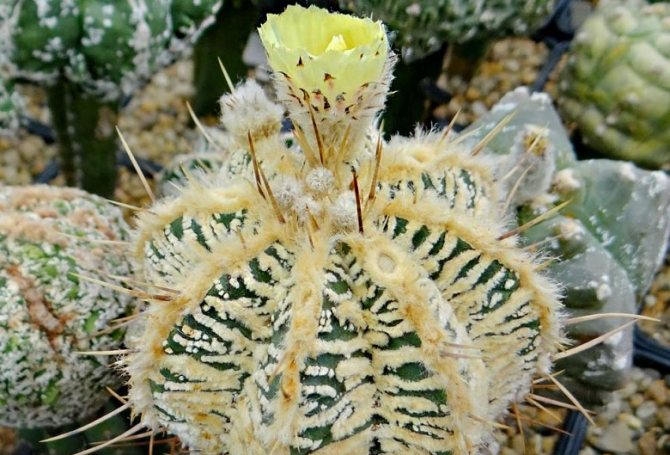

Kabuto variety Zebra
Humidity
The cactus treats low humidity calmly, and there is no need to spray it.But he loves fresh, oxygenated air, so the room where he is located must be ventilated. In winter excess moisture is especially detrimental to cacti. In damp and cold rooms, care must be taken so that putrefactive diseases do not develop.
The soil
There are many types of succulent and cactus earthen mixes in a specialty flower shop. But do not buy the cheapest substrate - it is often of poor quality.
You can use ready-made soil and add coarse river sand to it, because Astrophytum needs light soil, not saturated with organic and nutrients.
Be sure to add some crushed charcoal to prevent rot. The acidity of the soil should be close to neutral. You can prepare an earthen mixture in the old fashioned way:
- Sod land;
- Leafy land;
- Peat;
- Coarse river sand.
Take all components in equal proportions and mix thoroughly. It is advisable to ignite both types of earth in the oven; it is better to wash the sand with a weak solution of potassium permanganate and dry it. Also add crushed coal and a little zeolite.
Having taken care of the land, you need to take care of a good drainage system, water in no case should stagnate at the roots. 1/3 of the pot from the bottom should be filled with expanded clay or broken red brick. Moreover, it is also worth pouring drainage on top of the earth, it can be small pebbles. This technique allows you not to accumulate water at the neck of the rhizome.
By the way, a variety such as Astrophytum ibex needs a lot of calcium for thorns, so you can add crushed egg shells to the earthen mixture, but a little, otherwise it will stop growing. This additive can be applied to all thorny cacti.
Transfer
Astrophytums are transplanted, especially of mature age, very rarely - only in case of emergency. They are also transplanted when the "body" of the cactus has outgrown the diameter of the pot, or the root system has completely filled the container.
- When transplanting, make sure that the root collar does not turn out to be buried in the soil substrate - it should be at the same level with it.
- Transplant pots will need shallow, but wide, since the root system is poorly developed.


Fertilizer
Fertilizers for cacti are bought in flower shops. It is brought in in the spring-summer period once a month. The recommended dose should be halved and then diluted. In winter, cacti are not fed.
Reproduction
The cacti of the Astrophytum group do not have offshoots - children. Therefore, the plant is propagated by seeds. The freshness of the seeds is very important, since the seeds lose their germination for more than two years. Before sowing the seeds, they must be soaked in warm purified water for a short time (30-40 minutes), then kept in a potassium permanganate solution for 10 minutes.
The dried seeds are laid out on a soil mixture consisting of:
- 1 piece of leafy land;
- 5 parts of coarse river sand;
- ¼ crushed charcoal.
Then the seeds are lightly pressed into the soil and sprinkled on top with a thin layer. The container is covered tightly with plastic wrap or glass. This creates a greenhouse environment. The temperature should be between 20-22 degrees and the lighting is the same as for adult cacti.
During the germination and growth of seedlings, regular ventilation is necessary and, when the topsoil is dried, spraying.
The seeds germinate in one to two weeks. Be careful when watering young plants - cold water can kill them. When rounded balls appear on the surface, carefully dive them into separate pots.
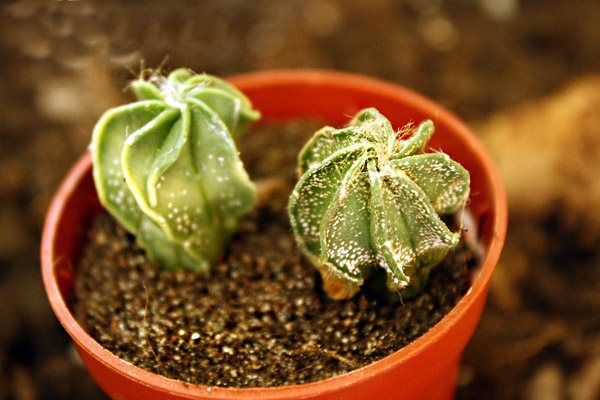

Seed propagation
Seed propagation is carried out in early May. Seeds of astrophytum are planted in shallow wide containers.
Step-by-step landing instructions:
- Fill the container with potting soil. The distance from the surface of the substrate to the edge of the flowerpot should not be less than 2 cm.
- Moisten the soil with a spray bottle.
- Spread the seeds over the soil surface. Do not sprinkle with earth!
- Put a plastic bag on the pot.
- Create optimal conditions for germination:
- Humidity - 10%.
- Lighting - bright diffused.
- The optimum temperature is 25 - 32 degrees.
- Airing 2 - 3 times a day.
Step-by-step instructions for caring for seedlings:
- After the first shoots appear (usually after 2-3 weeks), provide enhanced lighting. For maximum illumination it is recommended to use fluorescent lamps.
- Remove plastic bag gradually. Cover only at night.
- Watering - from a spray bottle.
- Dive when the seedlings begin to interfere with each other in pots 4 - 5 cm in diameter.
How to transplant astrophytum
The star cactus is rarely transplanted. Young plants are transplanted for the first couple of years every spring, then at the same time, but as needed (when the roots protrude through the drainage holes or the body of the astrophytum completely covers the soil surface).
The root system, like the stem, grows in width, so take a wide medium-deep pot for growing.
The soil needs a loose, medium fertility, neutral reaction. You can take a universal substrate for cacti and succulents as a basis, but add charcoal to it; for species with thorns, add crushed eggshells. To prepare the mixture yourself, you will need turf and leafy soil, coarse sand, peat. Take all the ingredients in equal proportions and mix thoroughly, pre-pour the sand with a steep solution of manganese and dry, bake the rest of the ingredients in the oven. Stir in some zeolite or charcoal.
Water should pass freely through the soil and be removed, so it is necessary to lay a drainage layer on the bottom of the pot, which will take up 1/3 of the container. Use expanded clay, pebbles or brick chips.
Transfer with an earthen clod so as not to damage the roots. After planting, the root collar should be at the same level. It is desirable to cover the surface of the substrate with fine gravel or decorative stones.
Bloom
Astrophytum myriostigma blooms at the age of 3-4 years. The flowers are silky yellow, large, up to 10 cm in diameter, wide open. Located at the top of the stem. Flowering of one flower lasts only 2 - 4 days. The rest of the flowers bloom on each new areola throughout the summer.
Plants, which in nature are accustomed to surviving in extreme conditions, become capricious and demanding on the windowsill. Creation of comfortable conditions (ideal temperature, humidity, feeding) leads to plant growth, its accelerated development, but not flowering.
What if it doesn't bloom?
Competent care of astrophytum implies the creation of conditions of detention close to the usual natural habitat of the plant.
- Place astrophytum in direct sunlight. In nature, this type of cactus grows under the scorching rays of the sun.
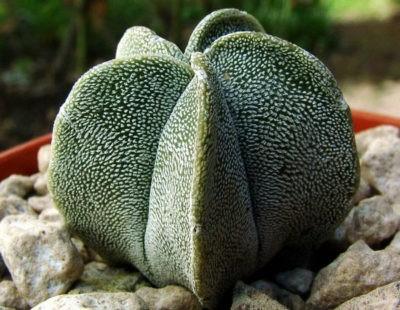

Do not turn!Astrophytums do not like changes in the direction of light. To prevent the trunk from twisting, make a turn once a year, in the fall.- Do not light up in winter! In the winter season, generally place them in unlit corners. Such wintering is favorable for bud setting.
- Establish competent watering. Check the functionality of the drain holes.
- In winter, place the plant on the balcony! At this time of the year, in the areas where astrophytum live, the temperature is quite low. If you do not lower the temperature during the dormant period, then all the energy will go into growth and development, and not into the laying of buds.
- Optimize feeding. Astrophytum grows naturally in very poor soils. An excess of fertilizer in the pot causes the plant to throw out the baby, not the flower.
Thus, by bringing the conditions of keeping astrophytum closer to natural conditions, it is quite possible to achieve its flowering.
Growing conditions
Illumination
All types and varieties of astrophytum are photophilous. For sufficient lighting, place the flowerpot on a south or southeast facing window.On hot summer days, it is better to shade at noon: lean a sheet of paper against the window or leave the blinds half-closed. Does not suffer from seasonal reduction of illumination, artificial supplementary illumination is not required.
Air temperature
In spring, it feels great at room temperature, comfortable for a person. For the summer season, it is recommended to take it out into the fresh air (on a balcony, loggia, terrace), protecting it from atmospheric precipitation. If this is not possible, try to ventilate the room more often. Cool wintering is necessary, otherwise flower buds will not develop. Keep in a temperature range of 10-12 ° C from late fall.
Similar species
- Astrophytum star - a cactus without thorns. For its resemblance to a marine life, it is called "sea urchin". The slowest growing cactus species.
- Astrophytum Capricorn or Astrophytum Capricorn - has long curved spines in the form of horns.
- Decorated astrophytum, aka Ornatum - has eight ribs. The areolae of the ribs are decorated with white spines. In nature, it can reach a height of 2 m.
- Astrophytum koahul - densely covered with white felt dots. It blooms with bright yellow large flowers with a purple-red core.
- Astrophytum jellyfish head - the stem is short, resembles a cylinder. With tubercles along the entire length. The bumps can be mistaken for leaves. Their length reaches 19 - 20 cm.
You can learn more about the types of astrophytum here.
Astrophytums are a very unusual and interesting group of cacti. Growing them is not easy and troublesome. But worries are "paid off" by the rare beauty of this valuable desert flower.
If you find an error, please select a piece of text and press Ctrl + Enter.
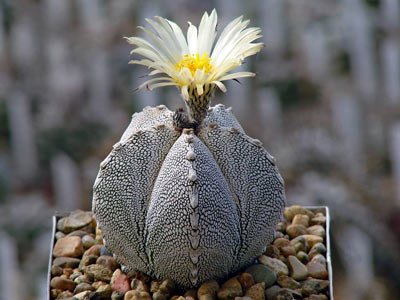

Often found in the collections of amateur florists, the species Astrophytum is a thousand-speckled, indoor plants of which also conquered the hearts of cactus growers: they
characterized by slow growth rates, early flowering, unique appearance and absolutely different thorns.
The history of the origin of the astrophytum cactus
In 1827, the first decorated cactus of the genus A. (Astrophytum ornatum) was discovered and described. Charles Lemaire introduced the genus in 1839, based on the description of A. mnogoryltsevago (Astrophytum myriostigma). This succulent has five edges and is very star-like. Although the discoverer of Astrophytum myriostigma is considered Galeotti, who gave the species the name “Cereus callicoche” - “starfish”.
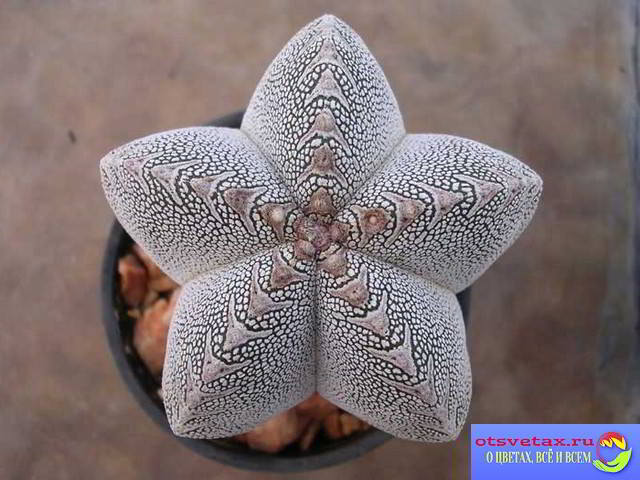

Lehmer identified the plant as a separate genus called Astrophytum. Translated from Greek Astrophytum means "plant-star", and "myriostigma" - a thousand points. The name of the genus and its distinctive feature was determined by the first plant assigned to this genus. Then 2 more traits were discovered that unite plants into one genus: the shapes of seeds and flowers.
Over time, other plant species were discovered and described. It was believed that the genus is well-established, but in 2002 a new species of A. head-medusa (Astrophytum caput-medusae) was discovered.
The genus consists of ten types of cacti and is divided into 3 groups according to analysis: flowers, specks, seeds, fruits.
- A.ornatum and A. Myriostigma are from Hidalgo, San Luis Potosi. Succulents grow up to one meter in height. The color of the flower is yellow. At the top of the plants, the fruits unfold. A. Myriostigma has no thorns. A. Ornatum is decorated with strong, straight spines.
- A. Coahuilense, A. Capricorne - native to the northern regions of Mexico. Compared to the previous group, they are smaller in size. The fruits of these plants are cracked at the base. A distinctive feature is the throat of red flowers. A. Capricorne has long, curled spines, while A. Coahuilense has no spines.
- A. Asterias is a native of Texas (USA), northern Mexico. The plant has flat ribs. Small in size, without thorns. The fruit will burst rather than crack. Flowers, the mouth of which is red.
A. caput-medusae has not yet been assigned to any of the groups.Scientists believe that it needs to be assigned to a separate group. There are also nudal forms in the genus - plants on which specks are completely absent. A prominent representative of A. myriostigma var. Nudum.
general description
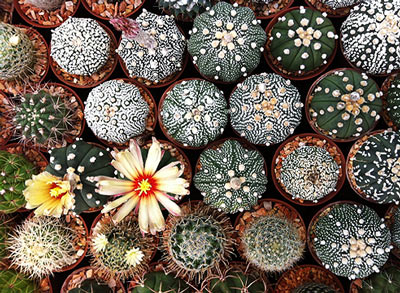

A succulent from the Cactaceae family, which grows in Mexico and the southern regions of the United States.
Young greenish-gray spherical specimens elongate over the years, forming distinct ribs, of which there are usually five.
This form became the reason for the emergence of the popular name "episcopal miter". During the flowering period, a large yellow flower 6 cm in diameter blooms at the end of the stem. The duration of the phase is no more than three days.
Growing problems
- The edge of the stem wrinkles, and the trunk itself becomes soft from below - excess moisture. It is necessary to reduce watering.
- Growth stops - in the summer season, watering is too rare, or excessively intensified in the winter.
- Brown specks appear - incorrect watering, which provoked the appearance of stem rot. In this case, the affected area is carefully cut off with rot, after which the substrate is disinfected. Humidification normalization is imperative.
- The configuration of the stem is arched - little light, or too high a temperature in the winter season.
Varieties of astrophytum
Species diversity allows you to create entire miniature cactus gardens without resorting to the use of representatives of other genera. Among the most popular are the following:
- Astrophytum Capricorn or Astrophytum Capricorn - a very attractive species with long and curved spines like horns, to which the cactus owes its name. The spherical stem stretches over time, reaching 25 cm in height and 15 cm in diameter.
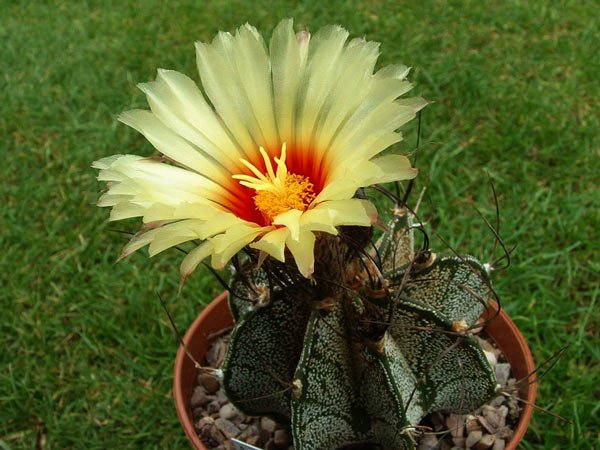

Each areola contains a maximum of 10 spines, 8 cm long, colored in shades of brown. After a certain time, the lower part of the stem remains without thorns. Adult specimens are able to form several yellow flowers with a red throat on the upper part at once, which bloom alternately, reaching 10 cm in diameter. Astrophytum Asterias or stellated astrophytum - the species combines the presence of white specks and curved spines. The cactus is characterized by very slow growth and flowering from the first years of life.
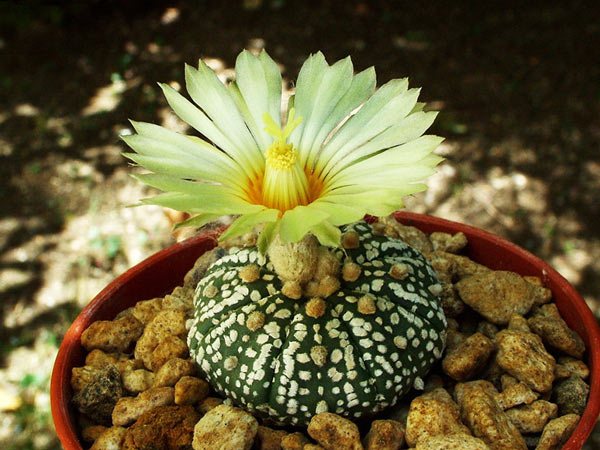

The duration of the flowering phase with proper care is from spring to mid-autumn. Each individual flower blooms for no more than three days and has a typical yellow color. Astrophytum jellyfish head - a species 19 cm high with an uncharacteristic appearance for the genus Astrophytum was discovered in 2002.
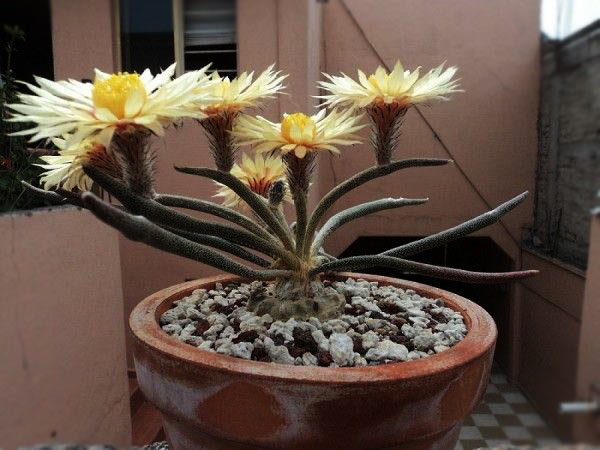

It is distinguished by light coffee or red bristles covering the cylindrical stem, and by 10-15 cm tubercles, on the tops of which typical yellow flowers are formed. Astrophytum polyphenyl (Astrophýtum myriostígma), or Astrophytum myriostigma, or countless speckled, or speckled - a variety with a spherical stem, the top of which is depressed, does not have spines. Differs in the presence of six ash-blue ribs.


Decorated astrophytum, aka Ornatum - a cactus with eight ribs, the areoles of which are decorated with shreds of white. With slow growth in natural conditions, the species can reach a height of 2 m.


The stem, elongating with age, is colored dark green and has transverse white specks characteristic of the variety, which form unusual patterns. The pale yellow flower reaches 10 cm in diameter.
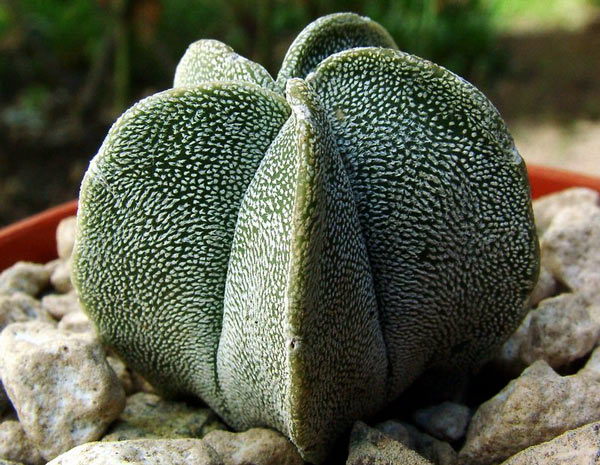

Botanical description and birthplace of the plant
Astrophytum (Astrophytum) or star cactus is a unique succulent native to the southern United States and northern Mexico. The plant is a star of rounded shape, the ribs are pronounced, there are 5 or more of them.This cactus is characterized by the presence on the surface of the stem of many light specks - these are bundles of hairs that can absorb moisture from the air. Only a few species have long spines at the edges of the ribs. The rest, thanks to the gray skin tone and the absence of needles, look like scattered stones that are surprisingly blooming.
Flowering astrophytum
From spring to autumn, buds appear at the top of the shoot from the areola. The pedicel is short, plump, covered with tomentose pubescence. Corollas are similar to a gerbera. The petals are 4-10 cm long, simple or double. The color scheme includes various shades of yellow. A single flower lives no more than three days.
Despite the slow growth, the flowering period begins early, and replanting is required once every 4-5 years. In culture, astrophytums are not difficult. Take a moderately nutritious soil for growing: add garden lime and charcoal to the lumpy clay soil. You can also vaccinate on echinopsis. Moderate summer watering alternates with absolute dryness of the soil in winter at a temperature of 6 ° C.
Coahulins or astrophytum koahulsky (A. coahuilense)
The stem of this cactus is smooth, without spines and pubescent areoles, but, like all species, it is covered with small light dots. The average number of grown, deep ribs is 5-6. With age, the ribs thicken and smoothen a little. This variety is distinguished by longevity - a succulent can exist for up to 150 years. It blooms with large yellow flowers. Usually fades after 2-3 days, after which others bloom. Photo: astrophytums coahlins ... It looks like myriostigma.
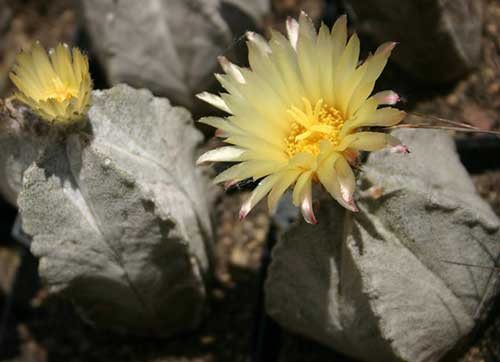

General information
Astrophytum was first discovered by Dr. Tomás Coulte in the Barranca de Venados Valley. This original spherical cactus, which has a gray-green stem with silvery dots and straight hard spines, is notable for the fact that it blooms with large light yellow inflorescences with a light, barely perceptible pleasant aroma.
Without exception, all varieties of star cactus are very popular with flower growers, so if you are a fan of exotic plants, astrophytum is perfect for you.
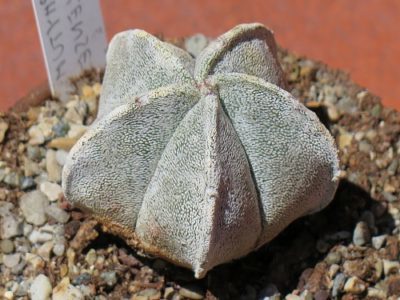

Ornatum or Astrophytum decorated - description of the species (A. ornatum)
The first cactus, described in 1827 under the name Echinocactus ornatus. Later it became known as Astrophytum ornatum (ornatum). The tallest of all types.


The photo shows decorated astrophytum - indoor plants of a spherical shape. With growth, the cactus lengthens, maintaining a diameter of 10-12 cm. It can reach 25-30 cm in height. In its natural environment, it grows up to 1 meter. The stem is dark green in color, with straight or slightly curved ribs, most often eight. Areoles are 2-2.5 cm apart from each other and contain 5-8 pcs of thin long spines in a bundle up to 4 cm long. The ribs are covered with horizontal rows of white blotches, creating patterns on the stem.
The species has one feature - it begins to bloom at the age of 6-7 years. Flowers have a pale yellow tint, up to 10 cm in diameter, bloom in early summer. The fruits are green.
The main problems and their solutions: table 2
Cacti have fewer health problems than deciduous plants, but they can also get sick if not cared for properly.
| Problem | Cause | Decision |
| Incorrect stem shape | Lack of light and high temperatures in winter | Move the plant to the sunny side, keep the room temperature no more than + 12 ° C in winter |
| Stem softening | Excessive watering | Reduce watering, wait until the soil is completely dry |
| Soft red spots | Wrong watering regime | Cut off all spots, dry the soil |
Astrophytum - what is this cactus?
Astrophytum belongs to the Cactus family. Its shape is spherical or cylindrical, representatives are small in height. A characteristic feature of most species upon external examination will be light specks on a greenish fleshy stem. If you look closely, you will see that these are bundles of hairs.They help the cactus survive by absorbing moisture.
In natural conditions
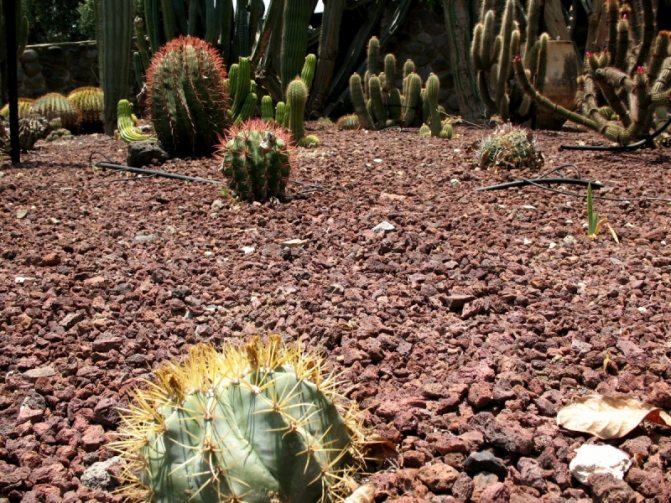

It looks like Astrophytum Ornatum in nature
The birthplace of astrophytum is the southern regions of the United States and northern Mexico, an area of semi-deserts and deserts. The growing regions are characterized by a high level of insolation and a large difference between day and night temperatures. In this case, the air is not cooled below zero. Like other cacti, plants grow singly or in groups, but in nature, as well as at home, they do not grow tall. Astrophytum loves clay soils in its natural habitat, which should not be forgotten when breeding.
Who is suitable for breeding
Astrophytum is not selective: it is quite unpretentious. Therefore, the flower is suitable not only for sophisticated lovers of exotic succulents, but also for beginners in home plant growing. However, this does not mean that the overseas cactus will grow and bloom in any conditions. It also requires its own irrigation and soil moistening regime, air temperature and humidity, light regime, soil composition. Therefore, before starting an astrophytum, it is necessary to carry out at least minimal theoretical training so as not to be disappointed in the poor results that the plant will give with improper care. The plant does not emit or accumulate any harmful substances. However, species with sharp thorns can pose a danger of an injection, so it is better to keep the cactus away from unintelligent puppies and small children.
Myths and superstitions about the prickly guest
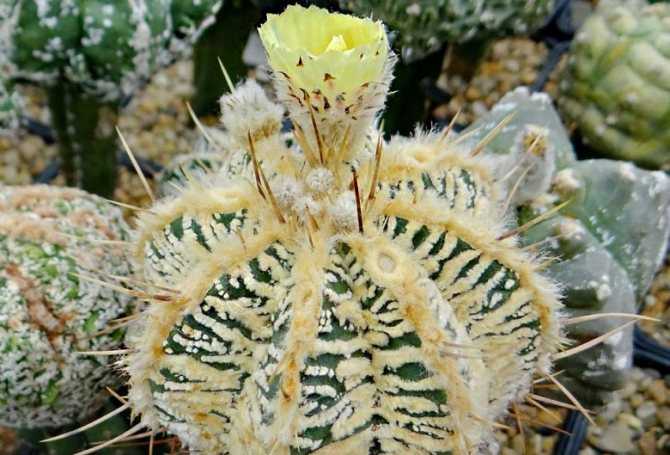

Astrophytum itself is neither good nor bad. He just is, and whether you like him or not, it only affects whether he will be a welcome guest in your apartment. However, many people believe that plants have their own energy and can influence the thoughts and well-being of the owner. The energy charge of astrophytum, in their opinion, is typical for a cactus: due to its spherical undivided shape and thorns, it is closed to the transfer of energy and is generally negative.
At the same time, it can be useful for people who need control over themselves. Also, the cactus is located in work rooms and workplaces, because it supposedly absorbs the negative effects of electromagnetic radiation from household and office equipment. According to the superstitions associated with the Cactus family, having an astrophytum in the house is to trigger loneliness and failure on the personal front. However, competent florists do not attach importance to these ideas.
Astrophytum transplant
The cactus does not need to be repotted frequently. It is carried out only in rare cases, with a strong growth of the root system and entanglement of the entire digger with it. The pot should be taken a little larger. At the bottom you need to put expanded clay, and on top, after transplanting a cactus, you need to put small pebbles.
When transplanting, it is very important not to deepen the root collar, so that over time it does not go underground and does not start to rot when in contact with liquid. The transplant is carried out by transshipment of an excavator. After the culture is transferred to a new pot, the empty spaces must be filled with prepared soil.
Do not water the cactus. Watering must be carried out only after a week, in order to avoid rotting of the root system, if it was disturbed when the plant was transferred from pot to pot. Within a week, it will dry out and will not rot on contact with moisture.
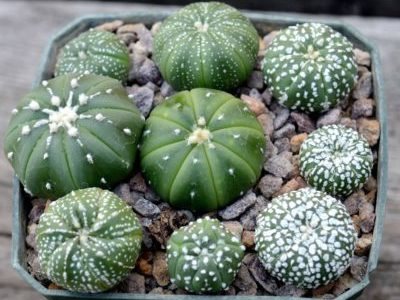

Features of growing some species
Each type of astrophytum has its own individual care needs. It is not difficult to take them into account when leaving, but if you ignore them, the plant may simply die.
Individual characteristics:
- Astrophytum ibex can stop growing if the soil is oversaturated with calcium or the acidity becomes low. Also, its roots can rot in an acidic or humus environment. There is a possibility of plant death with excess moisture in the winter. Water for irrigation of this species must be defended and artificially acidified, it can be watered with clean rainwater.
- Asterias requires more careful self-care. In the summer, he does not feel well in the sun, so he just needs a little blackout. From August to November, this cactus needs to be watered more than other species. Water it only in warm weather with warm water. But in December to March, watering should be suspended altogether.
- The structure of this cactus is also different from others. He has a long root system, so he needs to select a high pot. The composition of the soil must include clay. Moreover, the older the plant becomes, the soil should contain more clay.
- Decorated astrophytum is the most thermophilic of all species. It must always be kept warm. In winter, the temperature in the room should not be lower than +15 degrees. It must be grown on a windowsill on the west side, providing artificial shading.
Astrophytums cannot be called picky, it is enough to immediately understand the features of their cultivation. To do this, you need to familiarize yourself with some of the possible problems when growing cacti of this species.
Description of the succulent
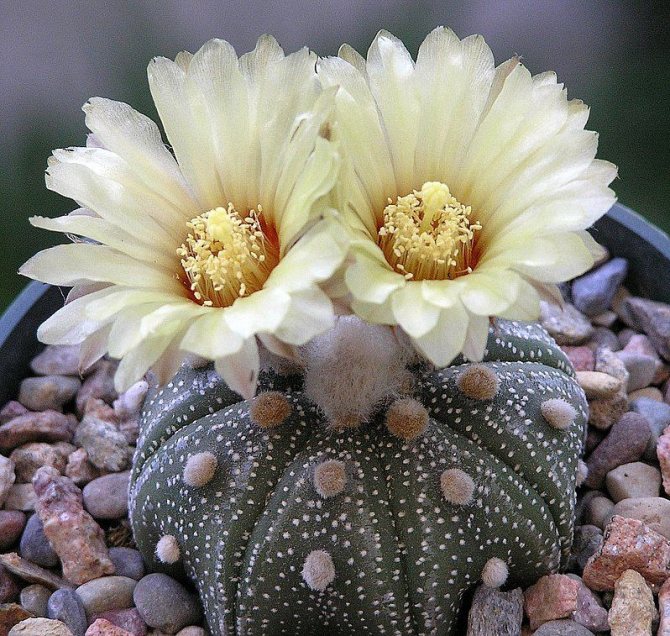

Due to its appearance and structural features, astrophytum is often called stellar or star cactus... It belongs to the genus of spherical or cylindrical succulents. Its characteristic feature is small dots located along the entire perimeter of the stem. If you look closely, you can see that these points are nothing more than tiny tufts of hairs designed to absorb moisture.
The bundles of hairs or dots are located differently for each representative. They can make up a variety of patterns. The stem of succulents has different texture, rib aberration and structure. Cacti of this species are so diverse in their unique appearance that they represent one of the most valuable succulents for collectors of this genus.
The appearance of astrophytum is so attractive that he is considered one of the most beautiful representatives of this genus... But, unfortunately, its beauty is short-lived. Cacti of this species have a characteristic feature. With age, rather large brown spots appear at the base of the stem. Then they spread up the stem. At this time, the plant lives fully, but its appearance can no longer be called attractive.
Astrophytum grows for a long time. If you grow it according to all the rules, the plant will bloom in late spring. It continues to bloom until late autumn. Flowers of different types can have different shades. Ranging from light yellow to orange, sometimes with red blotches. After 2-3 days, the flower withers, and a new one grows in its place.
Seedling care
After two to three weeks, the seedlings dive, strictly making sure that the distance between the shoots is from 2 to 3 mm. Young seedlings are not buried in the substrate. At night they are covered with a film, and during the day the film is removed.
Watering is carried out from a sprayer, not allowing the soil to dry out, but not flooding. Lighting - diffused bright light.
The second pick is performed at the stage when the seedlings are densely located next to each other. The distance between young shoots is three to five mm. A substrate for cacti is added to the planting container, if necessary. Thanks to the picks, the seedlings grow healthy and strong. In the first year of growth, they perform from 4 to six picks, in the second year, one or two.
When the plant reaches 2 cm in diameter, it is transplanted into a separate pot. Usually they use plastic cups, making holes in the bottom. After transplanting, once every 2 weeks, fertilizing is carried out with fertilizer for cacti (half of the recommended dose).
Important points in caring for seedlings:
- Direct rays of the sun from 08.00-11.00.
- Shading from 11.00 ... 15.00.
- Reduce lighting if seedlings turn yellow.
- If they are stretched, add light.
- The temperature in winter is not less than 15 ° С.
- Watering for the first wintering once every 30 days.
Reproduction: step by step instructions
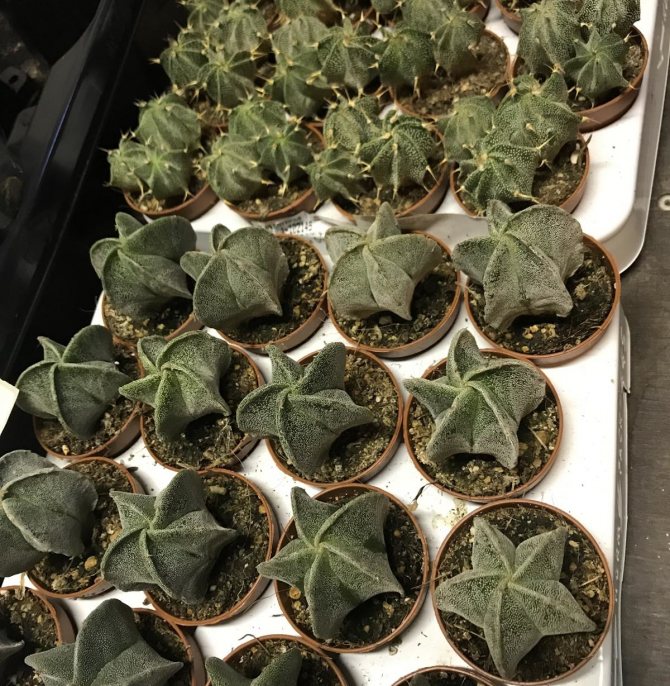

You can propagate a cactus only with seeds.Step-by-step instructions will allow you to do this quickly and efficiently at home.
- Dilute a weak solution of potassium permanganate and place the collected seeds in it (this will disinfect them).
- Prepare the soil by mixing in equal proportions leaf turf, sand and charcoal.
- Plant the seeds.
- Cover the pot with foil to recreate the microclimate of the greenhouse.
- Air and moisturize the seedlings daily.
- Maintain a temperature of at least + 20 ° C.
Seedlings should be watered only after the soil dries up in order to prevent waterlogging, which will lead to the death of the soil.
Subject to all the recommendations for keeping astrophytum at home, it will grow and develop, delight gardeners with beautiful flowering every summer. In the summer, the flower can be displayed on the terrace or in the country garden in a flower pot.
Fertilizers for astrophytum
During the spring and summer period, the plant should be fed regularly. Fertilizer should be applied once a month. For this purpose, a cactus feed diluted in water in half the dose of that indicated on the package is suitable.
In the autumn and winter periods, it is not necessary to fertilize the culture, since it is dormant.
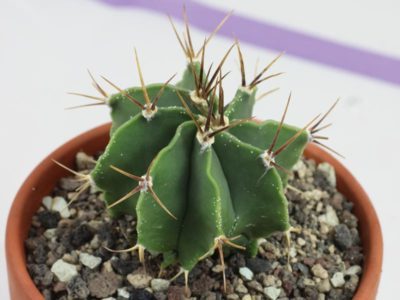

Possible problems
With improper cultivation of astrophytum, some external changes can be observed. Therefore, the cause can be eliminated immediately.
Unpretentious shade-loving indoor plants for an office or apartment
External changes and reason:
- at the base of the stem, there are spots of rot, a shriveled stem - this phenomenon can be observed, as a rule, in winter. The reason is waterlogging of the soil;
- there is no characteristic increase - waterlogging of the soil in winter and insufficient watering in summer;
- spots and plugs appeared on the surface of the stem - the cause is hypothermia, possible injury or the appearance of pests;
- the appearance of brown spots - stem rot appeared. A rare lesion, it is necessary to cut out the affected area, disinfect it with carbendazim solution and revise the conditions for keeping the plant;
- uncharacteristically elongated stem - the reason may be a lack of light in summer, overheating of the plant in winter.
In order for astrophytum not to be affected by such problems, it is necessary to initially create favorable conditions for growing and caring for it.
My collection of astrophytums
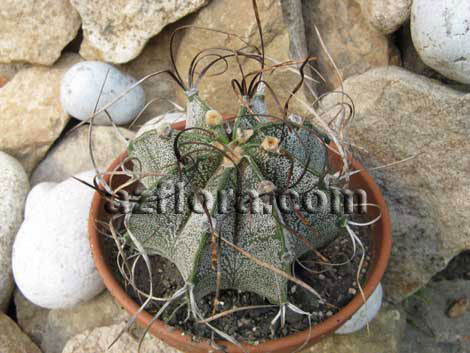

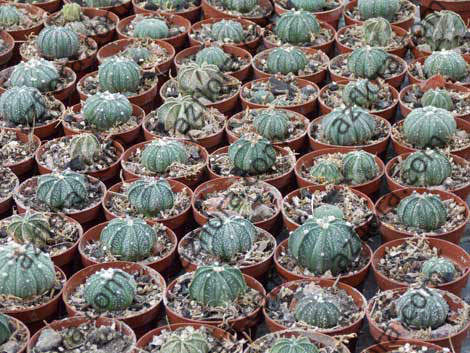

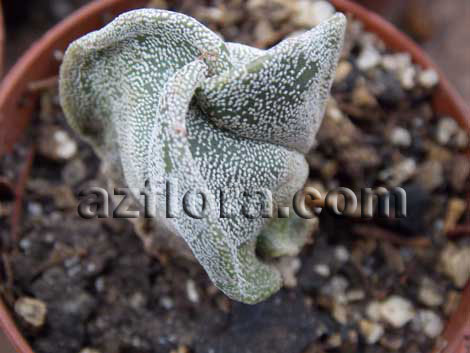

Related articles:
- Mammillaria.
- Cacti.
- Gruzoni.
- Lofofora.
- Gymnocalycium.
- Decembrist.
- Prickly pear.
Astrophytum jellyfish head - description of the species (A. caput-medusae)
Discovered in 2002 by researchers Carlos Velazco and Manuel Nevarez. This species was originally assigned to a separate genus Digitostigma. Its appearance is well described (digito stigma - speckled fingers). Some similarities with Ariocarpus agavoides and Leuchtenbergia principis have been noted.
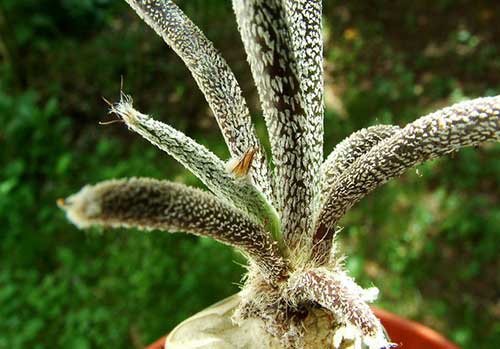

Digitostigma (Astrophytum) jellyfish head / Digitostigma (Astrophytum) caput-medusae ... It differs significantly from the known astrophytums.
A little later, scientist David Hunt proposed to transfer the cactus to the genus Astrophytum. The name "jellyfish head" (caput-medusae) is retained. Flowers and seeds are similar to the representatives of the genus already known to us.
Grows singly, rarely bush, stem is short, cylindrical. Height rarely exceeds 19 cm, width up to 5 cm. It is strewn with many bristles, painted in a light coffee color, sometimes with reddish tints. The base tubercles are slightly leaf-like. The root is approximately equal in size to the aerial part of the plant, in itself is rather fleshy, fusiform.
The upper layer of the stem is almost completely covered with grayish specks, colored light green. The spines are 1-3 mm long, slightly bent, strong. There are usually several of them. Spiny-bearing areoles are large, covered with white wool. Flowers 50 mm in diameter, located on growing tubercles.
Green fruit in the form of an egg. Ripening, it begins to dry out and crack in the horizontal direction. Seeds are black, shiny, 3 mm long, not more than 2 mm wide.
Astrophytum: general characteristics
A native of Mexico, Astrophytum has a spherical shape and is considered a real gem among cacti. Ribbed edges make it look like a star. Astrophytum is covered with white dots, which allows it to safely hide in the environment and merge with the landscape. A thick round stem is crowned with a white or yellow flower that lives for 2-3 days, leaving behind a box of seeds. Astrophytums are also found with red flowers, but they are so rare that they can only be seen in private collections.
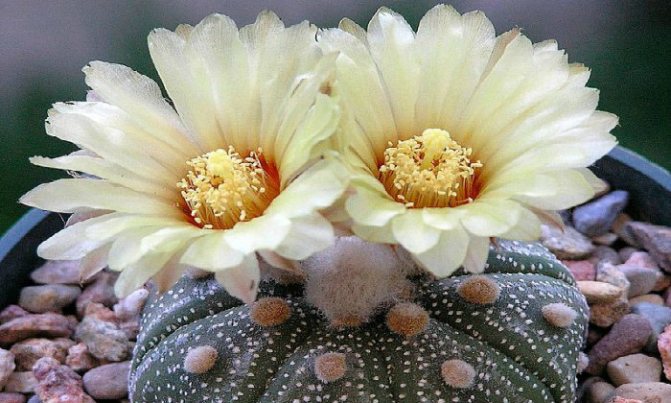

Flower features
An exotic plant is often found in home gardens. It attracts gardeners with its appearance. The stem of the cactus is like a star, which makes it unique. The trunk is bright green with pronounced or smoothed edges.
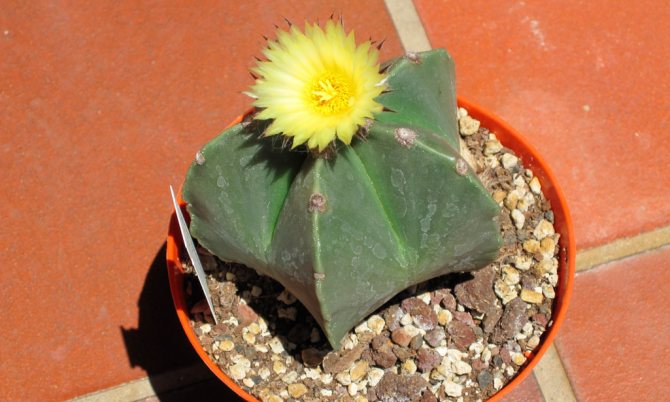

The plant blooms with a beautiful large flower with a mild pleasant aroma. The thorns are mostly absent or poorly developed, but some varieties are prickly.
How astrophytum reproduces
Cactus in a pot: examples of correct planting and options for several flowers
You can not only buy cacti already grown, but also plant them yourself. You need to know exactly how to do it right.
Using seeds
To grow astrophytum on your own, you need to act in stages:
- Soak. Seeds should be soaked for 5-7 minutes before planting. Moreover, it is better not in water, but in a weak solution of potassium permanganate.
- Soil preparation. The soil for germinating cactus seeds should have the following composition: charcoal, sand, sheet soil in equal amounts.
- Creation of a greenhouse. The resulting substrate is laid out in a shallow tray, the seeds of astrophytum are planted in it. Stretch plastic wrap or glass over the tray to create a greenhouse. Be sure to open it from time to time to ventilate and water the planted. The greenhouse is kept at a temperature of 20 degrees Celsius.
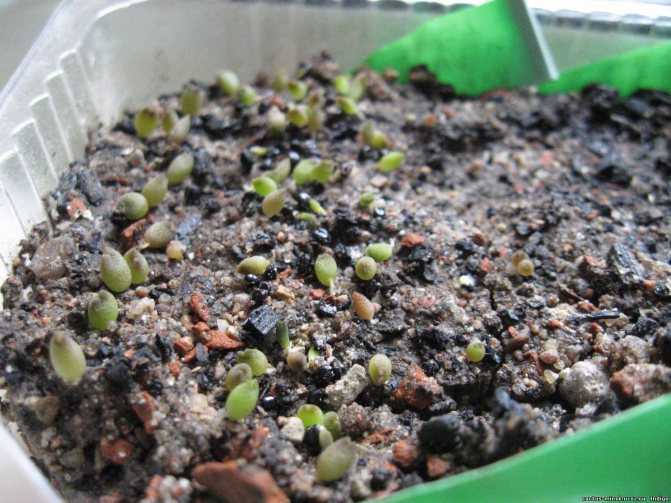

Astrophytum sprouts
The emerging sprouts can be transplanted into a pot with adult soil and drainage.
How it grows in nature
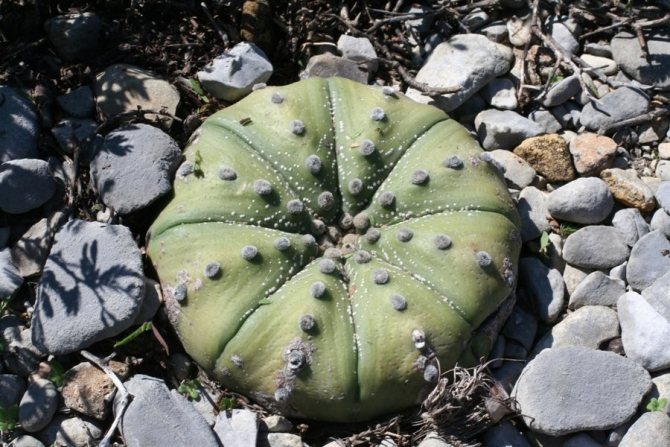

Astrophytum is native to the arid regions of Mexico and the United States. Under natural conditions, succulent grows on rocky or sandy soils. The cactus reaches a height of about 30 cm, and its diameter is within 17 cm.
In its natural habitat, the plant blooms in the summer. At the top of its stem, a peduncle appears, on which a bud is formed. Funnel-shaped yellow flowers, their length is about 8 cm. They fade a few days after blooming, in their place is a seed capsule.
Flowering astrophytum
The flowering time of a cactus usually falls in the middle of summer. The flowers of the culture have a yellow tint and silky petals with brownish tips.
Outwardly, they look like gerbera inflorescences. The middle can be either bright yellow or red - everything will depend on the variety. Some varieties of astrophytum exude a subtle, pleasant aroma during flowering.
The only disadvantage of the flowering period is that the inflorescences delight with their decorativeness for only a few days, after which they wither. When the cactus fades, it begins to form fruits, which, after ripening, can be used to multiply the culture.
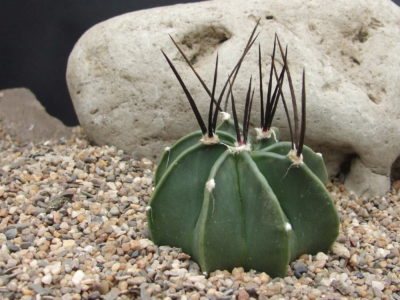

Watering astrophytum
During an active growing season, the plant requires regular and moderate watering. The land should dry out completely between watering. Water should be used soft, separated, at room temperature.
The flower grower needs to ensure that moisture does not accumulate at the root collar, as this will lead to decay of the root system and the death of the cactus. With the onset of autumn, watering should be minimized and the land should be kept dry in winter.
